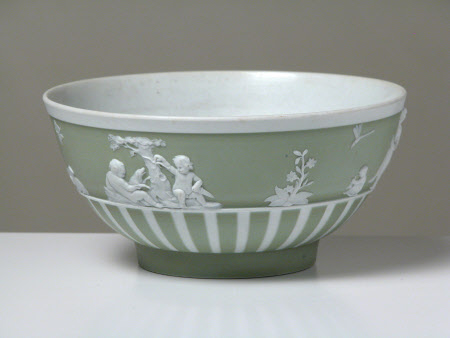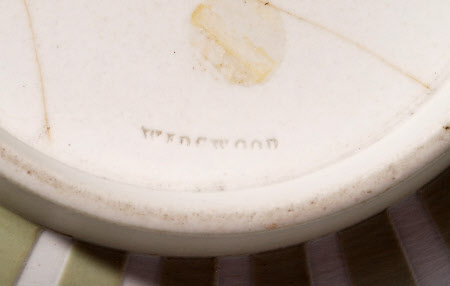Bowl
Wedgwood
Category
Ceramics
Date
c. 1787
Materials
Ceramics, stoneware, jasperware
Measurements
60 mm (Height); 128 mm (Diameter)
Place of origin
Stoke-on-Trent
Order this imageCollection
Stourhead, Wiltshire
NT 730523
Caption
Elizabeth Boughton, Lady Templetown, was an artist working across several disciplines, including painting, sculpture, wax modelling and cut-paperwork. The artist John Downman described her as ‘a Lady of great Taste and her Works greatly admired’. Lady Templetown is best known for the ‘cut Indian paper’ designs she produced for Josiah Wedgwood’s jasperware between 1783 and 1789. She was skilled at making images and silhouettes from cut paper, which was a popular polite creative activity, typically practised by women. Unusually, she was able to develop this into a professional practice. William Hackwood (c.1757–1836) translated Lady Templetown’s work into low reliefs that could be applied to the surface of vessels, plaques and small personal items, such as brooches. She created at least 15 designs for Wedgwood, who – no doubt seeing an opportunity to monopolise on her social cachet – acknowledged her role as designer in his 1787 ornamental-ware catalogue. He wrote that she and Diana Beauclerk (1734–1808), ‘whose exquisite taste is universally acknowledged, have honoured me with the liberty of copying from their designs’. This example shows a woman and child reading – it could be the one described in the 1787 catalogue as Study. Her designs encompassed fashionable Neo-classicism and ‘romantic’ subject matter. They ranged from scenes illustrating domestic virtues and interpretations of contemporary literature to depictions of goddesses and cherubs. Two series of designs – Domestic Employment and Maternal Affection – may have been created in collaboration with her relative Emma Crewe (1741–c.95), who also supplied imagery for Wedgwood. Born into an aristocratic family, Lady Templetown was bedchamberwoman to George II’s daughter Amelia. In 1769 she married courtier Clotworthy Upton (1721–85), who owned plantations and enslaved people on Grenada and Dominica. His Grenada estate was left in trust to Elizabeth upon his death.
Summary
Bowl, stoneware with green jasper dip and white applied relief decoration, Wedgwood, Stoke-on-Trent, Staffordshire, England, circa 1787, the design by Elizabeth Upton (née Boughton), Lady Templetown (1747-1823) and modelled by William Hackwood. An engine turned body with a frieze of 'Domestic Employment' motifs. Base impressed 'Wedgwood.' Lady Templetown was an amateur artist who, along with artists including Emma Crewe and Lady Diana Beauclerk, supplied Josiah Wedgwood with 'cut Indian paper,' a form of silhouette design, between 1783 and 1789. These were usually sentimental domestic scenes such as 'Domestic Employment,' 'Sportive Love,' and 'Poor Maria.' Her designs were translated into relief for jasper by William Hackwood.
Provenance
Unknown provenance.
Marks and inscriptions
Base: 'Wedgwood'
Makers and roles
Wedgwood, manufacturer William Hackwood, modeller Elizabeth Boughton, Lady Templetown (1747 - 1823), designer
References
Conroy, Rachel, Women Artists and Designers at the National Trust, 2025, pp. 80-83

